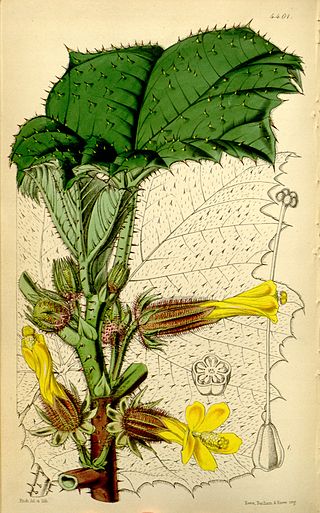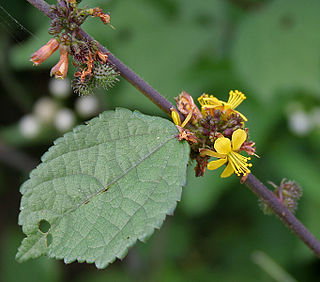
Abutilon is a large genus of flowering plants in the mallow family, Malvaceae. It is distributed throughout the tropics and subtropics of the Americas, Africa, Asia, and Australia. General common names include Indian mallow and velvetleaf; ornamental varieties may be known as room maple, parlor maple, or flowering maple. The genus name is an 18th-century Neo-Latin word that came from the Arabic ’abū-ṭīlūn, the name given by Avicenna to this or a similar genus.

Thespesia is a genus of 14 flowering shrubs and trees in the Hibiscus family, Malvaceae, although within the family they are more closely related to cotton plants (Gossypium). The genus is distributed from the South Pacific through Asia, Africa, and the Caribbean.

Urena is the genus of plants, which grow in various tropical and subtropical areas worldwide, although several species are Asian in origin. Some view Urena lobata as a weed, but others make use of its fibre for various purposes. The leaves and flowers are also a famine food in Africa. Its seeds are spread by animals. Fibres obtained from it are used for making coffee sacks in Brazil.
Paul Arnold Fryxell was an American botanist known for his work on flowering plants, especially those within the Malvaceae.

Phymosia is a genus of flowering plants in the family Malvaceae.

Robinsonella is a genus of flowering plants in the family Malvaceae. It contains sixteen species of trees occurring from Costa Rica to southern Mexico, eight of which occur in the Mexican state of Chiapas.

Wercklea is a genus of flowering plants in the family Malvaceae.

Talipariti is a genus of plants in the mallow family Malvaceae. It consists of 22 species, which are exclusively tropical except for one species whose range extends into temperate areas of Japan and Korea. Most authors now treat these species as part of the genus Hibiscus, in which case they form the section Hibiscus sect. Azanzae.

Triumfetta is a genus of plants in the family Malvaceae. Burbark is a common name for plants in this genus.
Allosidastrum is a New World genus comprising four species in the tribe Malveae in the family Malvaceae. Members of the genus are woody, bearing ovate leaves with long petioles. Flowers - borne without calyculi - bear small, basally rounded calyxes of a length greater than that of their pedicels and whitish or palely yellow petals. Gynoeciums each consist of five to nine carpels and mature into fruits that yield one seed for each of their carpels.
Bastardiastrum is a genus of flowering plants in the mallow family Malvaceae and is native to Mexico. They are shrubs or subshrubs with viscid stems.
Tetrasida is a genus of flowering plants belonging to the family Malvaceae.
Batesimalva is a genus of flowering plants belonging to the family Malvaceae.
Briquetia is a genus of flowering plants belonging to the family Malvaceae.
Dendrosida is a genus of flowering plants belonging to the family Malvaceae.
Periptera is a genus of flowering plants belonging to the family Malvaceae.
Sidasodes is a genus of flowering plants belonging to the family Malvaceae.








